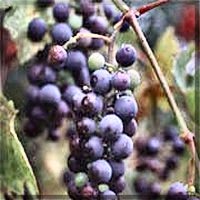

Vitis vinifera


Vitis vinifera
Origin - Europe
Part of the plant used - Seed, Fruit; Leaves, Oil (sap)
Edible Parts It is hardy and is frost tender, in flower from May to July, and the seeds ripen from September to October. The flowers are hermaphrodite (has both male and female organs) and are pollinated by Insects. The plant prefers light (sandy), medium (loamy) and heavy (clay) soils and requires well-drained soil. The plant prefers acid, neutral and basic (alkaline) soils. It can grow in semi-shade (light woodland) or no shade. It requires dry or moist soil.
Edible Parts - Flowers; Fruit; Leaves.
Pharmacology - Collagen, elastin and hyaluronic acid make up much of the inner wall and supporting matrix of the capillaries; when they are in good shape the capillaries stretch to let red blood cells through the tight places and do not let the fluids in the blood leak out. Proanthocyanidins have shown a marked tendency to accumulate in tissues with high contents of glycosaminoglycans (complex amino sugars), such as capillary walls and skin. This may also apply to cartilage and synovial fluid. Proanthocyanidins have also shown antimutagenic effects in vitro at high concentrations (250mcg/ml).
Proanthocyanidins (also known as leucoantho-cyanidins) are a form of polyphenol, which is in turn a form of bioflavonoid. Proanthocyanidins are at least 15 to 25 times more powerful than vitamin E in neutralizing the iron and oxygen species free radicals that attack lipids. Grape seed extract is used for fighting free radicals and maintaining capillary health. It is very similiar to pine bark extract, with a high content of proanthocyanidins (see active properties). Proanthocyanidins are found in many foods, but freezing, cooking and canning deactivate them.
Medical Uses - Grape seed extract is used for its free-radical-fighting capabilities, and for a variety of conditions related to capillary health and permeability. It is synergistic with vitamin C – which is more potent and absorbed more rapidly when used together with proanthocyanidins. Proanthocyanidins have been indicated for:
Free radicals do damage in the capillaries in two ways:
Toxicity, Cautions & Contra-indications - Grapes also contain sugar and/or alcohol from fermentation or as part of the extraction process. Skin rash may develop due due to the procynidolic component of the grape seed Grape seed should be used only when clearly needed during pregnancy